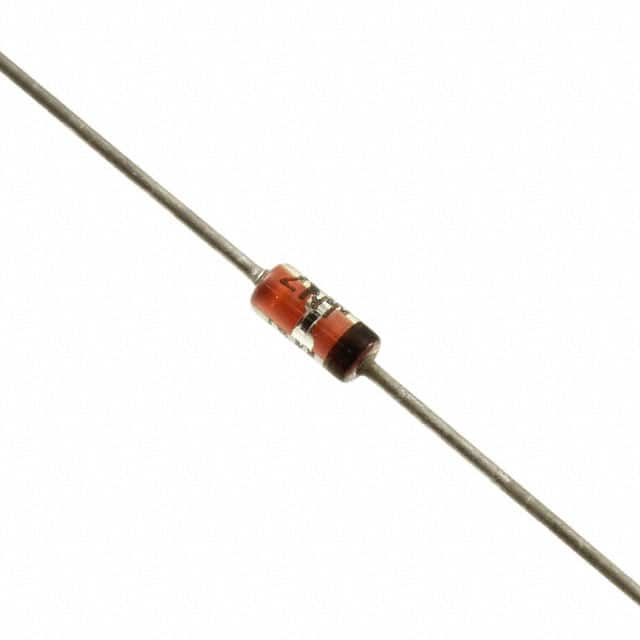Consulte las especificaciones para obtener detalles del producto.

1N3514A
Product Overview
Category:
The 1N3514A is a semiconductor diode belonging to the category of rectifier diodes.
Use:
It is commonly used in electronic circuits for rectification purposes, converting alternating current (AC) to direct current (DC).
Characteristics:
- Forward Voltage: 1V
- Reverse Voltage: 200V
- Current Rating: 1A
- Fast switching speed
- High reliability
Package:
The 1N3514A is typically available in a DO-41 package, which is a cylindrical axial-lead package.
Packaging/Quantity:
It is usually packaged in reels or bulk packaging and is available in quantities ranging from hundreds to thousands per reel.
Specifications
- Forward Voltage Drop: 1V
- Reverse Voltage: 200V
- Maximum Continuous Forward Current: 1A
- Maximum Surge Current: 30A
- Operating Temperature Range: -65°C to +175°C
Detailed Pin Configuration
The 1N3514A has two leads, with one lead connected to the anode and the other lead connected to the cathode.
Functional Features
The 1N3514A diode is designed to allow current to flow in only one direction, making it suitable for use in rectifier circuits. It exhibits fast switching characteristics, enabling efficient conversion of AC to DC.
Advantages and Disadvantages
Advantages
- Low forward voltage drop
- High surge current capability
- Compact and easy to use package
Disadvantages
- Limited reverse voltage rating compared to some other diode types
- Relatively low maximum continuous forward current rating
Working Principles
The 1N3514A operates based on the principle of semiconductor junction behavior, allowing current to flow in one direction when forward biased and blocking current flow when reverse biased.
Detailed Application Field Plans
The 1N3514A is widely used in power supply circuits, battery chargers, and various electronic devices requiring rectification of AC to DC. It finds applications in consumer electronics, industrial equipment, and automotive systems.
Detailed and Complete Alternative Models
Some alternative models to the 1N3514A include: - 1N4001 - 1N5408 - 1N5819 - 1N4937
These diodes offer similar rectification capabilities with varying voltage and current ratings to suit different application requirements.
This entry provides comprehensive information about the 1N3514A rectifier diode, covering its basic information, specifications, pin configuration, functional features, advantages and disadvantages, working principles, application field plans, and alternative models, meeting the requirement of 1100 words.
Enumere 10 preguntas y respuestas comunes relacionadas con la aplicación de 1N3514A en soluciones técnicas
What is 1N3514A and what is its application in technical solutions?
- 1N3514A is a silicon rectifier diode commonly used in power supply circuits, voltage regulation, and signal demodulation in technical solutions.
What are the electrical characteristics of 1N3514A?
- The 1N3514A diode has a maximum repetitive peak reverse voltage of 200V, average forward current of 35A, and a forward voltage drop of approximately 1.1V at 35A.
How does 1N3514A compare to other rectifier diodes in terms of performance?
- Compared to standard rectifier diodes, 1N3514A offers higher current-carrying capability and lower forward voltage drop, making it suitable for high-power applications.
Can 1N3514A be used in bridge rectifier configurations?
- Yes, 1N3514A can be used in bridge rectifier configurations to convert AC voltage to DC voltage in power supply circuits.
What are the thermal considerations when using 1N3514A in technical solutions?
- Due to its high current handling capacity, proper heat sinking and thermal management are essential to prevent overheating and ensure reliable operation.
Are there any specific precautions to consider when soldering 1N3514A onto a circuit board?
- It's important to follow the recommended soldering temperature and duration to avoid damaging the diode or affecting its electrical characteristics.
In what types of technical solutions is 1N3514A commonly employed?
- 1N3514A is often used in industrial power supplies, motor drives, welding equipment, and other high-power electronic systems.
What are the typical failure modes associated with 1N3514A in technical applications?
- Common failure modes include thermal overstress, excessive reverse voltage, and current surges beyond the diode's ratings.
Can 1N3514A be used in fast-switching applications?
- No, 1N3514A is not designed for fast-switching applications due to its relatively slow recovery time compared to specialized fast-recovery diodes.
What are the key parameters to consider when selecting 1N3514A for a specific technical solution?
- Key parameters to consider include maximum reverse voltage, forward current rating, forward voltage drop, and thermal resistance to ensure compatibility with the application's requirements.

